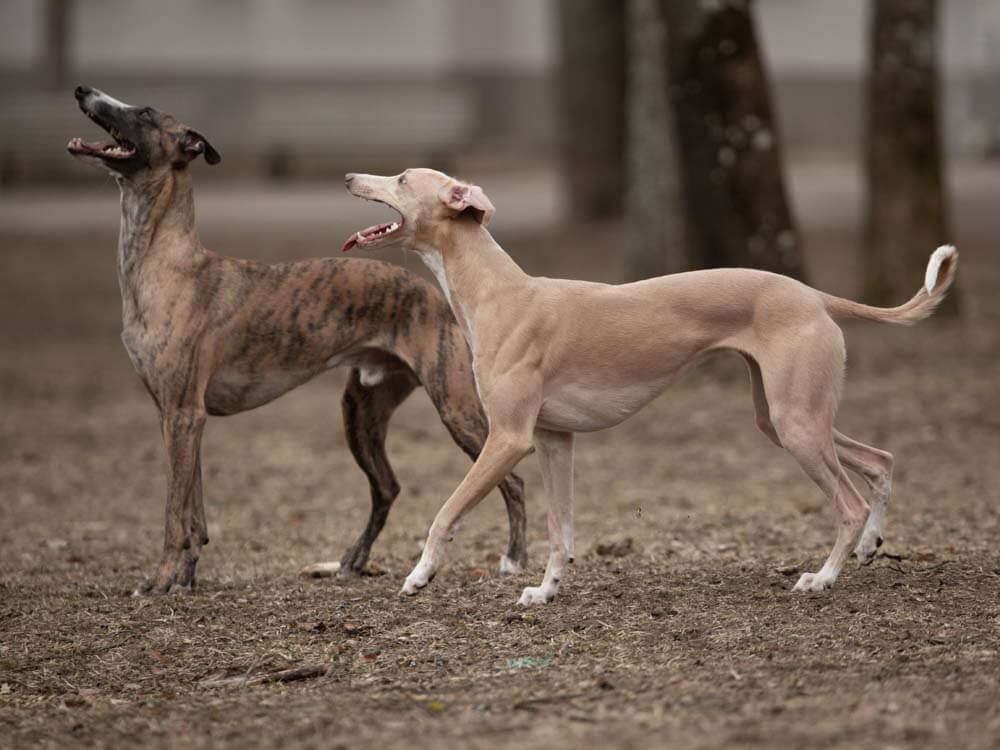Whippet Character
The whippet’s unique temperament has been deeply influenced by its historical evolution. While it is considered a working dog, whippets were never bred to hunt in packs like other hunting breeds. Instead, they were typically found in castles and manors, making them unsuitable for harsh outdoor conditions or the role of guard dogs.
A Close Bond with Their Owners
Although whippets hunted rabbits and entertained their owners in dog racing, they always lived alongside their families under the same roof. They enjoyed leftover meals from the family table and rested by the fireplace or on soft sofas and armchairs.
The Most Successful Racers Ran to Their Owners
Unlike modern-day racing whippets that chase a lure, the most successful whippets of the past raced towards their owners waving a piece of cloth. This practice historically shaped the loyal, owner-oriented character of the breed. The best racers were those most devoted to their owners.
For these reasons, whippets naturally became affectionate family dogs, deeply attached to their owners. They possess a strong prey drive, a competitive spirit, and an exceptional ability to form close bonds with their families.

Whippets at Home
At home, whippets are typically quiet and gentle companions. They enjoy spending their time lounging on the sofa or resting in their soft beds. Friendly toward other animals and welcoming to guests, whippets are tolerant of children and not prone to destructive behavior.
Instead of reacting aggressively or growling, a whippet confronted with a loud or threatening child will most likely retreat or find a hiding spot. However, due to their trusting and friendly nature, whippets are generally poor guard dogs. Many whippets won’t even bark when a stranger enters the house. To them, every new encounter with a person is often seen as an opportunity to make a new playmate.
It’s worth noting, though, that some whippets can be naturally timid and distrustful of strangers. These dogs form deep, unconditional bonds with their family members, relying on their close connection for comfort and security.
Male vs. Female Whippets: What’s the Difference?
Unlike many other breeds, male whippets are just as easy to manage at home as females and are no more aggressive. In fact, males are often more affectionate and loyal to their owners compared to females. They also tend to enjoy repetitive games for longer periods, making them a great fit for young families with active children.
Females, on the other hand, typically have a slightly more independent and complex nature. While still very attached to their owners, they may display more self-reliance. Physically, males are slightly taller, larger, and heavier than females, which can be a factor when choosing between the two.

Can You Train a Whippet Not to Climb on Sofas?
It is possible, but keep in mind that lounging on sofas feels like an inherent right for whippets—a tradition dating back to the days when they ruled the halls of castles and manors.
The good news is that whippets are exceptionally clean dogs. They shed very little, and their short, smooth coat doesn’t bring dirt into the house. Their coat is not only easy to maintain but also simple to protect from unwanted parasites like ticks. For these reasons, whippets make excellent sofa companions.
However, if keeping your dog off the sofa is a top priority, a whippet may not be the best breed for you.
How Much Exercise Does a Whippet Need?
Whippets are sprinters, not long-distance runners, so they don’t require a lot of exercise. However, giving them the opportunity to run freely is essential for their health and emotional well-being.
Whippets also enjoy long walks, and many owners take them along for jogging sessions. For young whippets, games with other dogs, or activities like fetching a ball or frisbee, are great ways to tire them out quickly.
Before bringing a whippet into your life, it’s important to plan how you’ll meet their exercise needs. Aim to provide at least 4–5 higher-intensity activities per week, such as running with another dog or chasing toys like sticks, balls, or frisbees. These should ideally be in a safe, fenced area to ensure their safety.
For additional insights and updates about whippets, follow us on Instagram!


